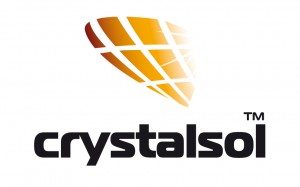 Solar energy is a favourite of many governments and environmentalists: free and easy to harness energy from the sun – what’s not to like about that? Well, for one the production of conventional photovoltaic panels isn’t without environmental impacts, and it also uses rare metals which are increasingly difficult to source. Crystalsol, established in 2008 as a spin-off of the Tallinn University of Technology, is developing a product which gets rid of these negatives.
Solar energy is a favourite of many governments and environmentalists: free and easy to harness energy from the sun – what’s not to like about that? Well, for one the production of conventional photovoltaic panels isn’t without environmental impacts, and it also uses rare metals which are increasingly difficult to source. Crystalsol, established in 2008 as a spin-off of the Tallinn University of Technology, is developing a product which gets rid of these negatives.
The company’s key innovation is the use of tiny semiconductor crystals made of copper, zinc, tin and sulfo-selenide, CZTS for short, where each crystal works as a tiny solar cell. This technology is the combination of decades of research for the Russian military and Philips semiconductor know-how dating back to the 1960s. The result: a new type of flexible photovoltaic module with a significant cost advantage compared to all currently known photovoltaic technologies. The modules are produced roll-to-roll – think paper manufacturing – which eliminates the scale-up issues that thin film producers usually face. Once production is up and running, which should be by mid 2011, Crystalsol forecasts production costs below €0.50 per watt, which should give them the lead in low cost PV modules.
The team behind Crystalsol consists of Wolfgang Ressler, Thomas Badegruber, Prof. Dieter Meissner and seven employees, as well as a dedicated team of ten scientists at the Technical University of Tallinn. Investors are Conor Venture Partners Oy from Finland and Energy Future Invest AS from Norway. Additionally, the company is supported by several other agencies. So far the company has received €3m in funding, and is seeking a further €7 to complete its product development.
I asked Wolfgang Ressler what makes them different to their competitors. Wolfgang told me that there’s no direct competition, as currently no other company is developing a similar technology to them, but if you take a broader view there are plenty of players, ranging from start-ups like Heliovolt and Nanosolar to established corporations like Q-Cells and First Solar. What makes Crystalsol’s technology different is that it is based on CZTS and thus there is no need for rare metals such as tellurium and indium. The production of the semiconductor is separated from the module production and their product opens up completely new ways to integrate solar cells into buildings, roofs and facades. Add in a cost reduction of 70 to 80% compared to the current industry average and you have a very attractive product which could revolutionize the photovoltaic market.
![]() Established in 2008, the company started out during one of the worst recessions since the 1930s, and I asked Wolfgang, who’s one of the three managing directors of the company, how they coped during these tough times. He was very optimistic and proud that the company was able to complete its seed financing round successfully. He views the current situation as beneficial for Crystalsol, as it means an increase in available talent and lower prices for equipment and raw materials.
Established in 2008, the company started out during one of the worst recessions since the 1930s, and I asked Wolfgang, who’s one of the three managing directors of the company, how they coped during these tough times. He was very optimistic and proud that the company was able to complete its seed financing round successfully. He views the current situation as beneficial for Crystalsol, as it means an increase in available talent and lower prices for equipment and raw materials.
Given their unique technology, optimism and their outstanding management team, I believe Crystalsol has what it takes to succeed. Creating a product which does away with a harmful production process while driving down production costs is one thing, but to also aim to minimize the environmental impact of the product over its entire life-cycle shows that the company is thinking more deeply. To target the building integration industry for its first market is, in my opinion, a smart strategy, as I believe huge buildings with glass facades could benefit immensely from the ability to produce energy while minimizing the incoming sunshine. If you are curious about Crystalsol, come and meet them at the Cleantech Venture Day 2009. It takes place on November 26th in Lahti’s Sibelius Hall and tickets are still available here.




